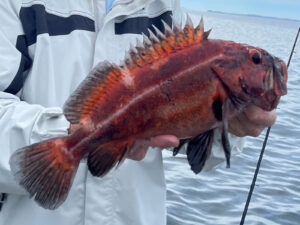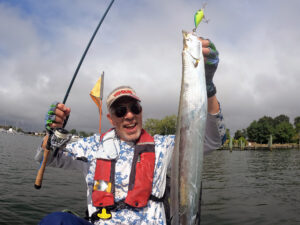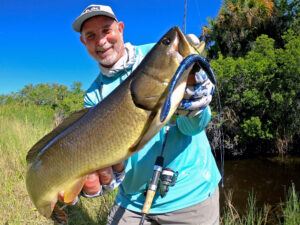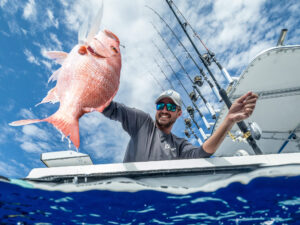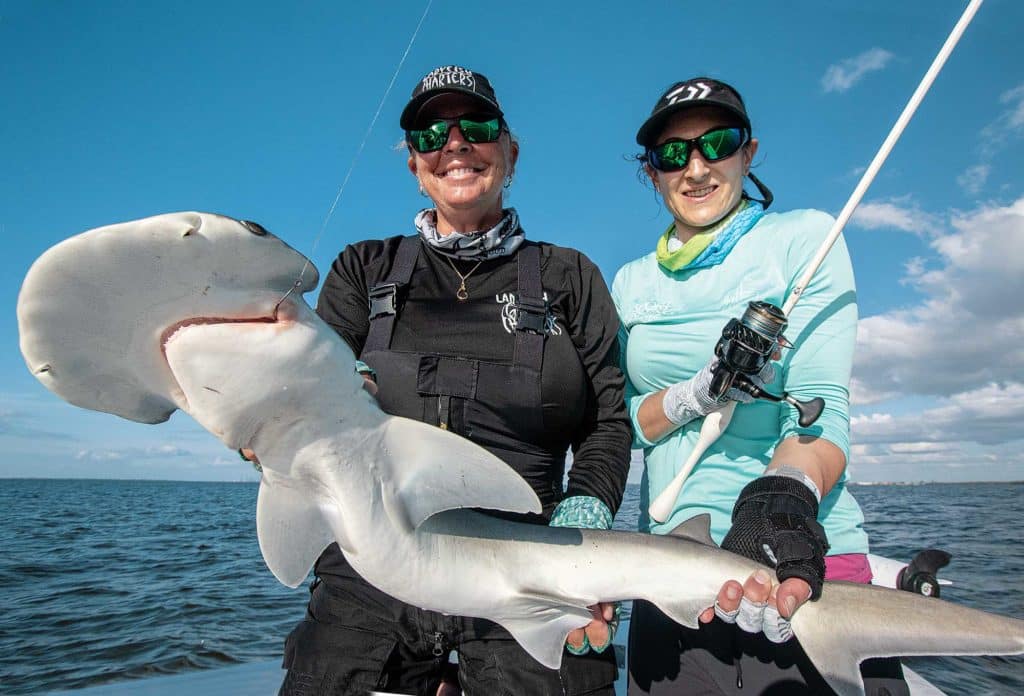
The Covid-19 pandemic saw a hefty increase in new boaters and anglers, many just getting their feet wet in the world of fishing. And sure, well-known fish species are easy to identify, but you better believe there was and continues to be plenty of head-scratching when an odd-ball or nondescript fish gets scooped into the net.
Below, we identified some common fish species you’ll likely catch in Florida Gulf or Atlantic waters. That’s not to say these fish can’t be caught in other southern states — many, in fact, are caught all over the Southeast. Still, these fish can be confusing in their similarities to other species or unfamiliar to the untrained eye. The internet is unforgiving, and asking for fish identification in online fishing groups often leads to plenty of useless, salty comments. So, skip that mess and check this page first to see if the Florida fish you caught is here. As with any fish species you’re not familiar with, play it safe by taking a picture and releasing it. With state and federal seasons and regulations to abide by, you better be able to identify the species in your cooler.
Atlantic Bumper
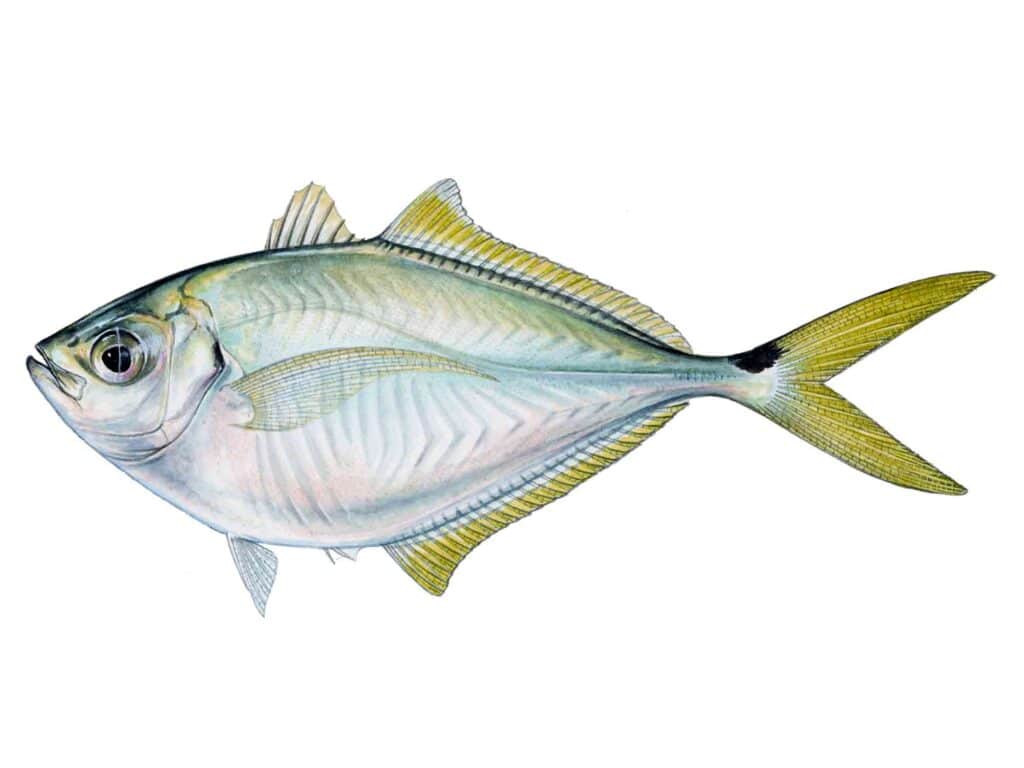
When trying to catch live bait off the beach, in the bay or near an inlet — mostly when using a sabiki rig or tiny bits of shrimp or squid — you’re likely to catch the Atlantic bumper (Chloroscombrus chrysurus). Unfortunately, the Atlantic bumper and a similar species called the leatherjacket (Oligoplites saurus) have lousy reputations as fish-catchers — whether that’s true or not. For whatever it’s worth, I caught my largest tarpon from a kayak trolling an Atlantic bumper on a circle hook outside the surf near a southeast Florida beach.
Both baitfish species fall in the Carangidae family of jacks. What’s worse, both baits have the ability to be a real pain in your hand.
The Atlantic bumper, sometimes called a butterfish or hornbelly, has two small, spiky fins on its belly that will easily tear up your hand to the point of bleeding. The Atlantic bumper is identified by its yellow tinted fins, silver sides, and black spot on its caudal peduncle just before the tail. A bumper’s body is compressed and deep, with mild curves in the forward section at the head. To add confusion to one of the Atlantic bumper’s nicknames, there’s another fish species called the butterfish (Peprilus triacanthus) that’s used to catch striped bass and tuna.
The silvery leatherjacket is much longer in stature than the Atlantic bumper, growing to a max of about 10 to 11 inches. The leatherjacket, sometimes called a skipjack or leather jack, has dorsal and anal fins that can deliver considerably painful venom, making this species even nastier to handle than Atlantic bumper. Just use your de-hooker and don’t touch the things. The sting from a leatherjacket is said to feel worse than a saltwater catfish.
A Florida “Bonita”
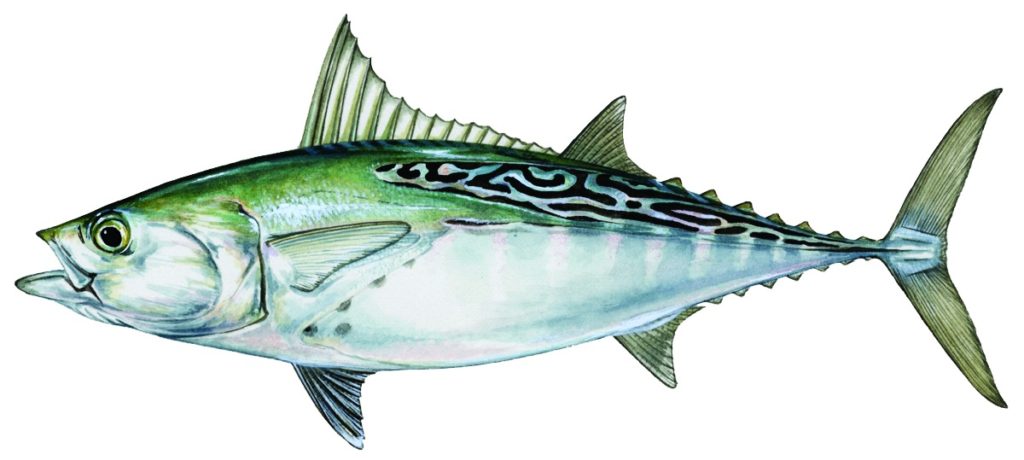
Probably the most common of the “tuna” caught nearshore Florida, bonita have an absolutely confusing name. Even in Florida they’re called “bonito” or “bonita.” Florida’s bonita (Euthynnus alletteratus) are regularly called different names in other places, including false albacore or little tunny. Bonita are part of the Scombridae family that includes tuna and mackerel, but are not part of the genus Thunnus (true tunas). That makes bonita more closely related to mackerels than well-known tunas such as yellowfin, bluefin or blackfin.
In general, bonita can be identified by wavy, diagonal dark stripes along the back and dark spots under each pectoral fin. Plus, bonita have no teeth like the Atlantic bonito (Sarda sarda). And bonita have little value as a food fish, compared to say the albacore (Thunnus alalunga) of the Pacific. The current world record little tunny weighs more than 36 pounds, caught off Spain.
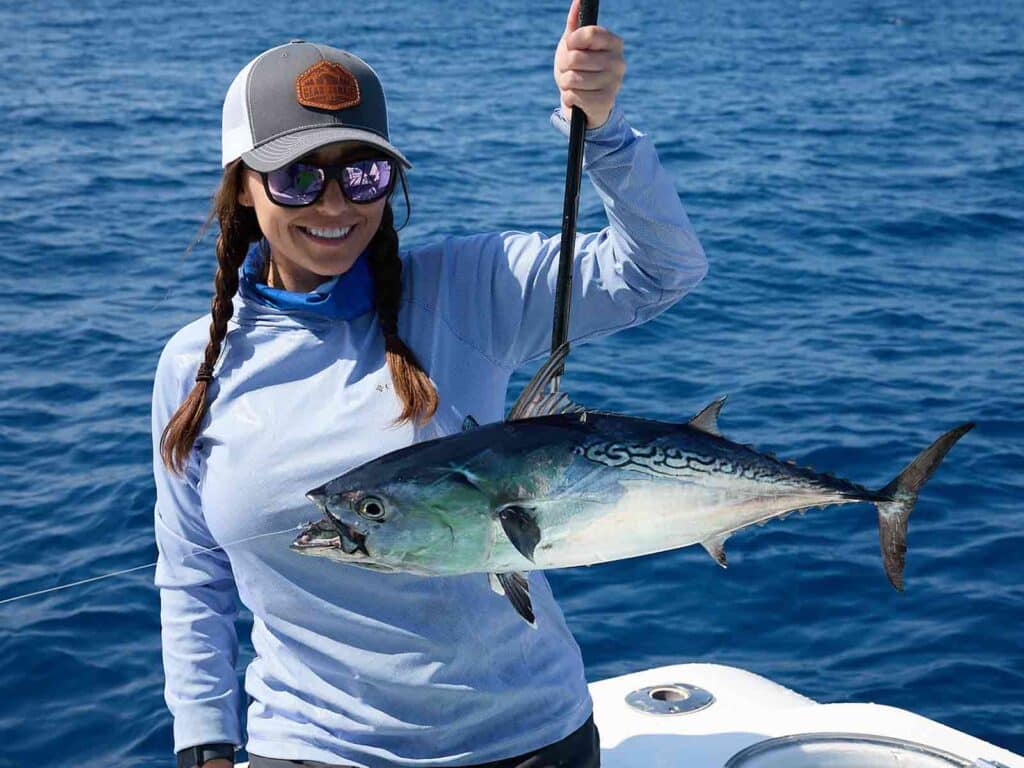
Bonita make up for a lack of taste with great fighting ability. Northeast fly anglers love to target false albacore, and that trend is growing along the Atlantic Coast down to Florida. More and more captains in Florida are now targeting bonita as worthy opponents on light tackle. Still, many Florida anglers currently catch bonita as an accident, and they’ll keep one or two to chunk up as bait or chum, but won’t hang around long near a school before moving on.
Bonnethead Shark
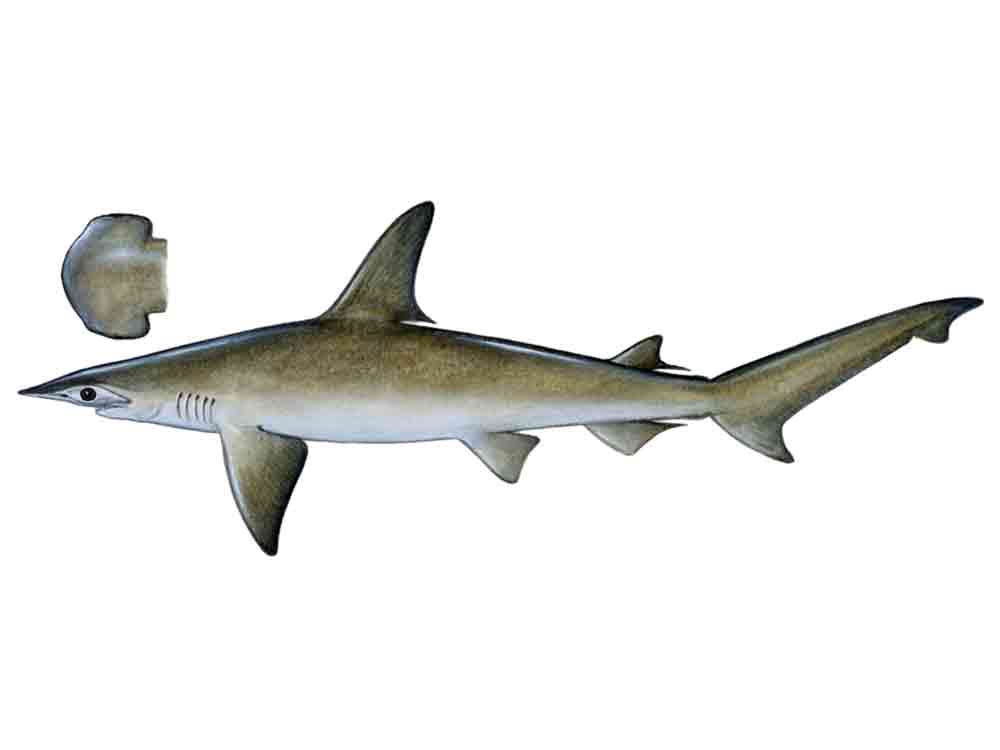
Most anglers can identify this species as a shark, but they often mistake it for a true hammerhead. The bonnethead shark (Sphyrna tiburo) is the smallest member of the hammerhead family. The maximum length they grow to is about 4 feet, and that’s a large one. The head of a bonnethead is curved and shaped more like a shovel, while a hammerhead’s face has straight lines and sharp corners like a symmetrical double-bit axe. If you’re fishing in an estuary or the surf, chances are a bonnethead is the shark you’re most likely to catch.
Anglers fishing with shrimp catch these fish on the flats, in the surf and off ocean piers. In particular, bonnethead sharks love shrimp, crabs and other mollusks. I remember once fishing with small, live crabs for bonefish and permit on a Florida Keys flat. Well, we didn’t catch any of the target species, but we did see the amazing stalking capabilities of full-size bonnetheads. As soon as that crab hit the water, these sharks could sense it and used side-to-side tracking movements to quickly locate the squirming crab. We watched the action happen in seconds in the clear Keys water.
Lookdown
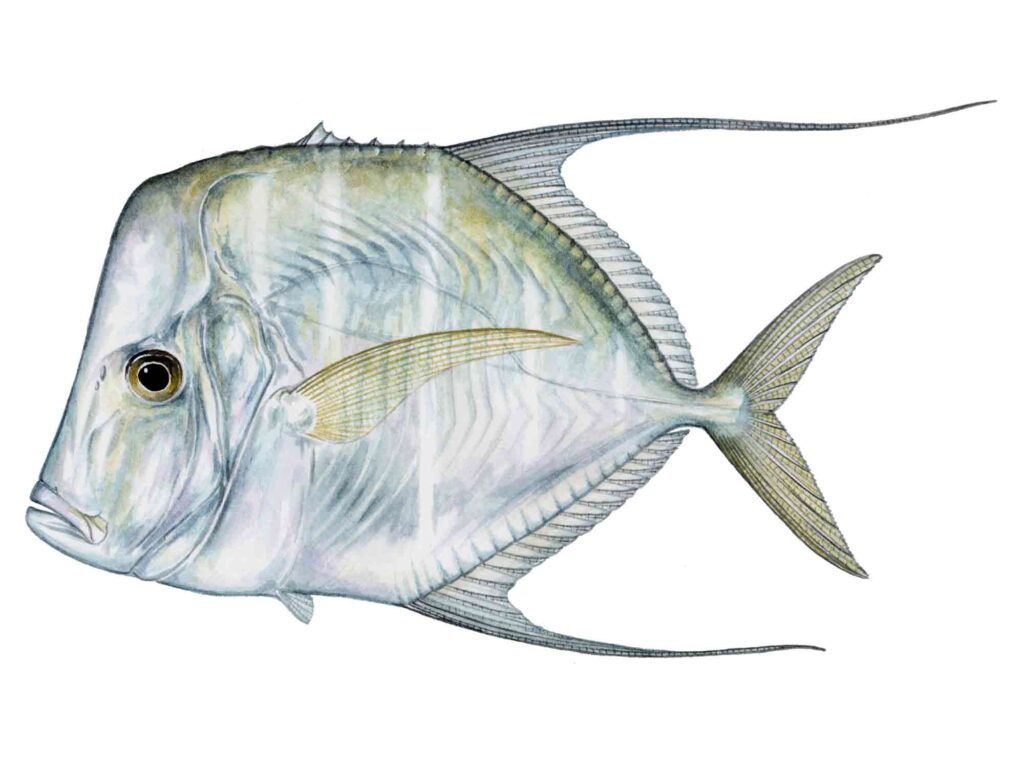
The first time I ever caught a lookdown, I was fishing around dock lights well after dark. Tarpon, snook and seatrout were my targets, but this weird looking fish shaped like a plate bit my shrimp imitation instead.
Lookdowns (Selene vomer) have silver and iridescent coloring, with a very steep front head. You might even call it a forehead. A lookdown’s body is thin and compressed, with its second dorsal and anal fins featuring long filaments. Swimming freely in the water, a lookdown does appear to look down toward its delicate mouth, hence the name. Lookdowns are caught in coastal waters on shrimp and other crustaceans, often over sand bottom. They don’t grow particularly large — one-pounders are the usual.
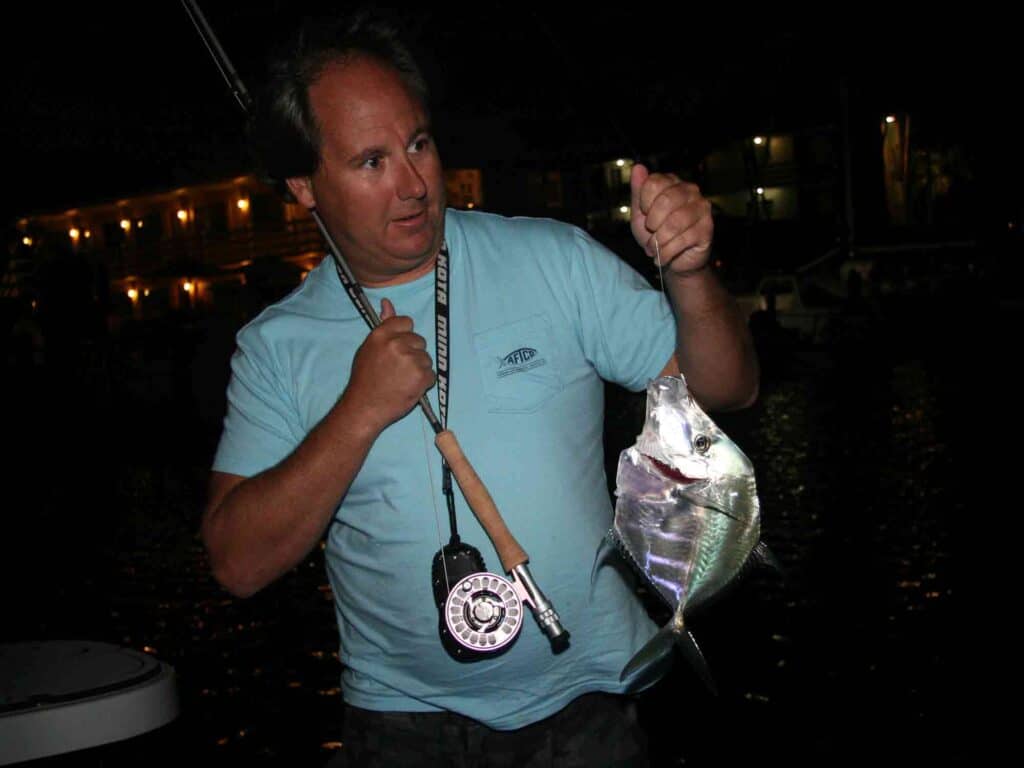
A similar fish with a steep head is called the moonfish (Selene setapinnis). Atlantic moonfish have more of a jack look to them — read that as tougher — and don’t have any long filamented fins. Both species can be mistaken for each other because they feature a distinct steep face with eyes set above the mouth. But the two species are different, even if anglers mistakenly use the names interchangeably.
Mojarra
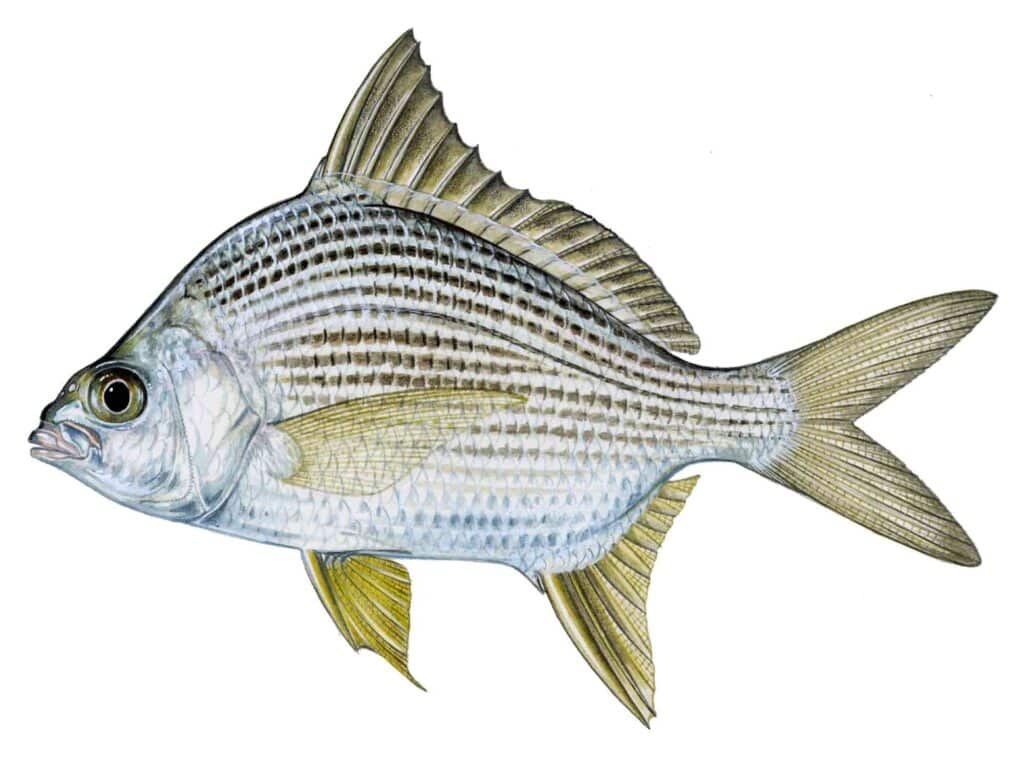
The mojarra is a small species of baitfish you might catch in a cast net. The largest ones can be caught on a hook with natural baits, such as shrimp. In particular, surf fishermen catch them when targeting other species such as pompano. And if they’re big enough to fillet, mojarra go right into the cooler for eating too.
Mojarra, sometimes called sand perch, are great baits for snook fishing. If you’ve ever wanted to know the origin of the fishing meme “Snook Candy,” this was that baitfish trying to be identified.
In Florida, there are a couple species of mojarra, including tidewater mojarra (Eucinostomus harengulus), Irish mojarra (Diapterus auratus), and striped mojarra (Eugerres plumieri). The most common is the striped mojarra, regularly hanging in large schools far upriver in brackish waters. The striped mojarra features an olive-colored back and silver sides, almost like a metallic sheen look. Black stripes are prominent along the top of the fish, with those stripes trailing off toward the belly. A pointy dorsal fin starts tall, with the fin progressively shortening as it flows along most of the back. The striped mojarra also has three rigid anal spines.
Palometa
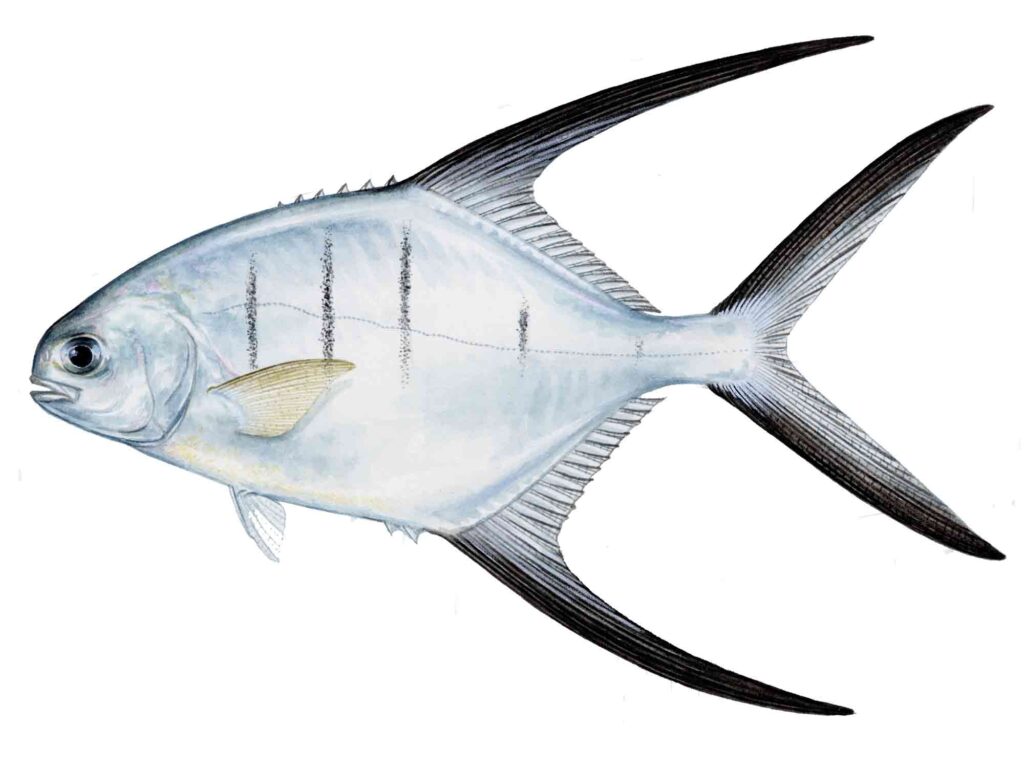
If you’re familiar with permit and pompano, this similar-looking jack species could leave you confused. The palometa (Trachinotus goodei) is in the same genus as Florida pompano (Trachinotus carolinus) and permit (Trachinotus falcatus), but doesn’t grow as big in Florida as the other two species. In fact, newbie surf anglers have a hard-enough time differentiating an 11-inch pompano and permit — because they do look darn similar. One main difference is the permit’s dorsal and anal fins tend be longer and darker black in color.
The palometa species is not all that common. Where it’s most often landed is along the sandy beaches and clear waters of southern Florida. Swimming just inside or outside the breakers, palometa have overly elongated dorsal and anal fins almost to the point of looking sinister. In The Lion King, if Mufasa is a permit and Simba is a pompano, then Scar is a palometa. Palometa also have four narrow bars on their sides, with subtle traces of a fifth bar near the tail section.
Most anglers don’t chase after palometa, but catch them as bycatch when targeting other pompano. Palometa almost never grow larger than 20 inches and don’t weigh more than a pound or two.
Pigfish
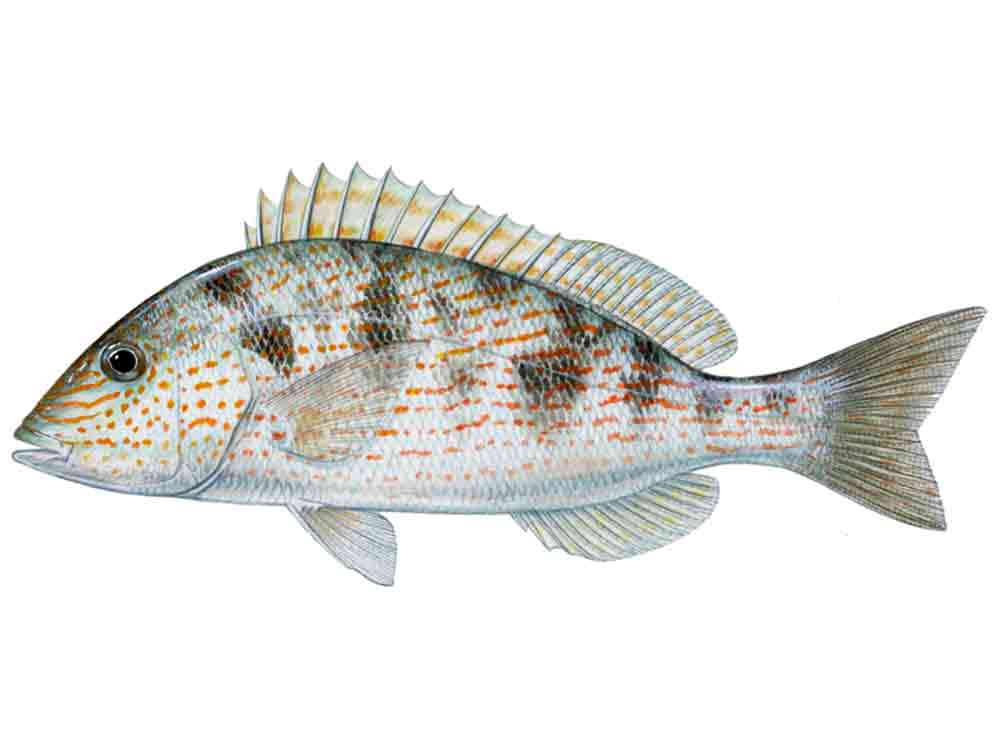
The pigfish is one of those hand-size, colorful Florida fish you catch on a chunk of squid while trying to make bait in the morning. Often found over grass flats, near structure such as docks, or even near mangroves or corals, pigfish are pretty enough to live in a fish tank. They also happen to be great bait for fish like snapper, grouper, snook and redfish.
Pigfish (Orthopristis chrysoptera), sometimes called a grunt, make a grunting noise with their pharyngeal teeth. Piggies are light brown or gray in color, usually paired with a bluish tint. And they don’t grow longer than 12 inches usually. The most obvious identifying marks are the small orange and blue dots across their body.
Other species that get mistaken for pigfish are similar-size pinfish (Lagodon rhomboides), although pinfish have yellow and green stripes and a black dot on the gill cover. And then there’s the white grunt (Haemulon plumieri), commonly called a Key West grunt, that makes grunting noises just like a pigfish. But the white grunt has a larger, more lippy mouth almost like a grouper. Its common colors are greys with touches of bronze reds and yellows, plus there are blue stripes on its head. Check inside the mouth of a Key West grunt and you’ll see it is bright reddish orange.
Some other Florida grunt species you’ll likely catch include sailor’s choice (Haemulon parra), tomtate (Haemulon aurolineatum) and bluestriped grunt (Haemulon sciurus).
Sand Seatrout
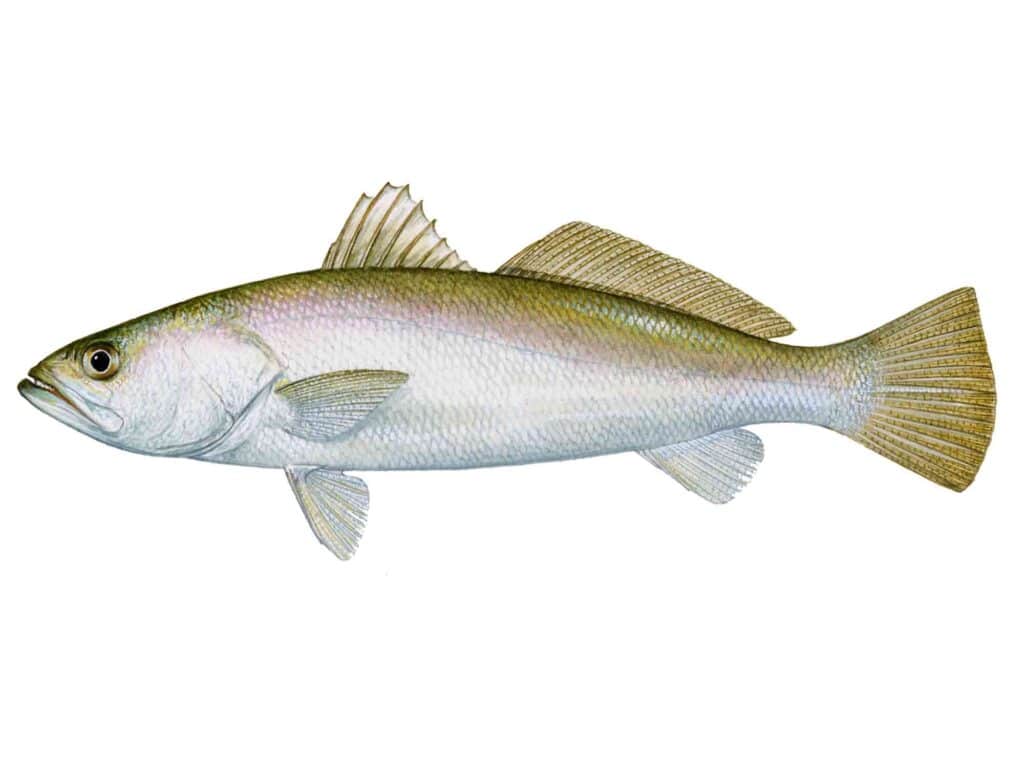
The speckled seatrout (Cynoscion nebulosus) is the king of the Florida grassflats. But “yellowmouths” aren’t the only trout in town. In fact, there are a number of Florida fish in the genus Cynoscion that fall under the drum and croakers family.
The trout without the over-abundance of spots is named the sand seatrout (Cynoscion arenarius), or sand trout for short. Sand trout, sometimes called white trout, have a tan yellow body that fades to white at the belly. White trout do have a pair of canine teeth like speckled trout, but lack the dark spots along the back. Sand trout are commonly caught over sand flats where they can school up in large numbers.
Here are some other trout species to look out for:
- Silver seatrout, Cynoscion nothus (These trout are more silver in color and smaller-sized than specks, plus they have an oversized eye and shorter snout that ends abruptly.)
- Weakfish, Cynoscion regalis (Found in the northern sections Florida, a weakfish’s upper sides have wavy lines of small, irregular spots that differentiate them from other Florida trout species. In Atlantic states farther north, weakfish grow much larger than speckled seatrout.)
Spot
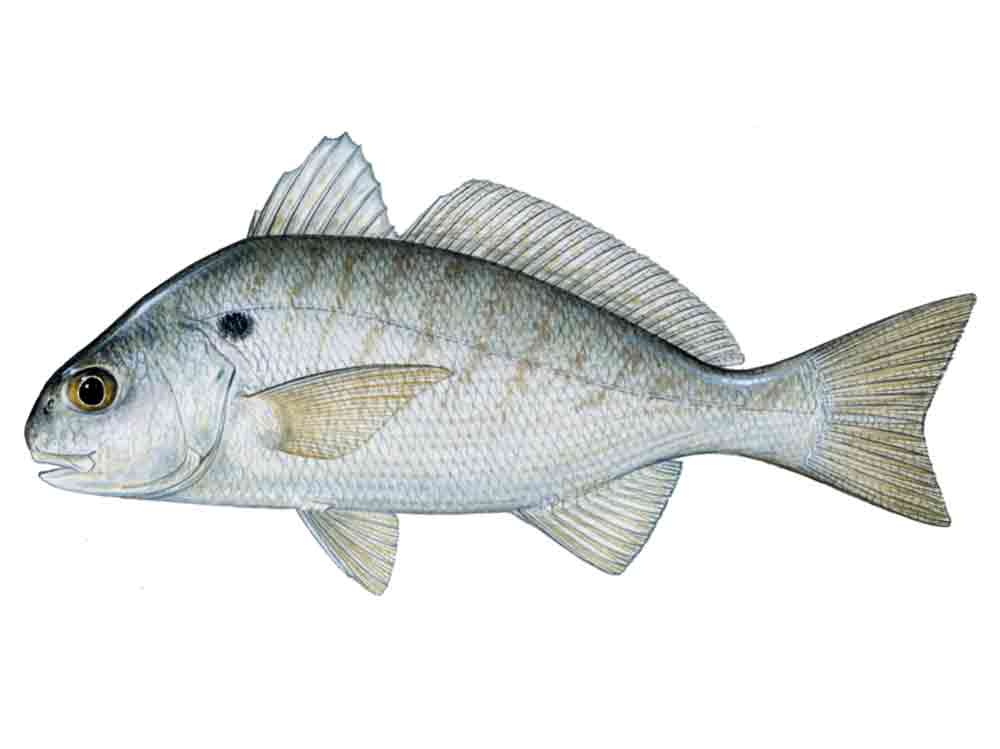
The spot (Leiostomus xanthurus) and Atlantic croaker (Micropogonias undulatus) are often confused as the same fish species. Although each croaker species is known as a top baitfish, they are tasty to eat if large enough to fillet. The two fish look similar in some ways, with both regularly caught at sizes under 12 inches. Each fish also has lines on the upper portion of the body that sit vertically, although spot tend to have less lines total.
Here’s how the two species are different. The spot has a dark spot behind its gill cover, plus it’s the only drum in Florida with a forked caudal fin. The Atlantic croaker has a strongly serrated preopercle, which means it has a boney spot on the cheek. The Atlantic croaker also has small barbels at the jaw and no large spot. Both species eat invertebrates such as crabs, shrimp and clams, so you’re not likely to catch them on plugs or live baitfish.
Whiting
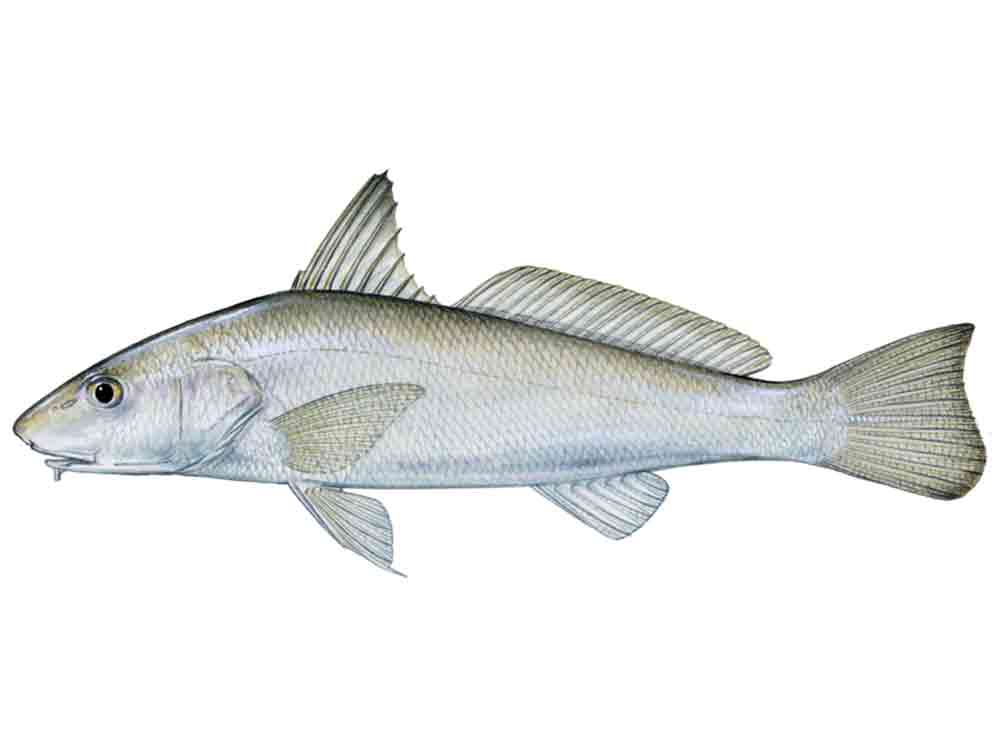
This fish species goes by plenty of names. In Florida, it’s often called a whiting. In North Carolina, they call it a sea mullet. Just about anywhere it swims, you might hear scientists refer to the fish as a kingfish (although it’s not a king mackerel). Whatever you call it, the whiting is a prized surf species to eat, probably only second to pompano. You mostly catch them on heavy surf tackle, so the fight isn’t great, but whiting are not a species you target for catch and release sport. The largest whiting I ever caught was in a deep creek on a soft plastic near St. Augustine. So, the surf isn’t the only place to catch them. Other hot spots include sandy areas just inside inlets and passes.
In total, the general whiting name covers a couple different species, including Gulf kingfish (Menticirrhus littoralis), northern kingfish (Menticirrhus saxatilis), and southern kingfish (Menticirrhus americanus). The three species mostly look the same, but have different coloring and slight differences. In general, all whiting species have a dorsal fin that stands tall like a proud acute triangle, plus barbels on the lower chin. Their mouth is underslung like a redfish, ready to chew up crustaceans such as crabs and shrimp. And all whitings have a similar body shape, growing to a max length of 18 to 19 inches and not heavier than 3 pounds.

